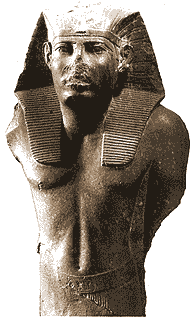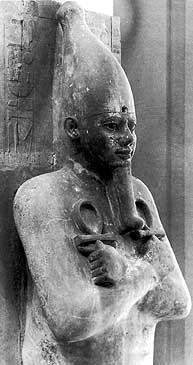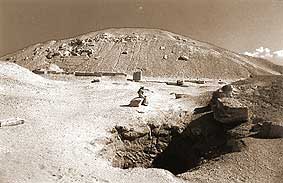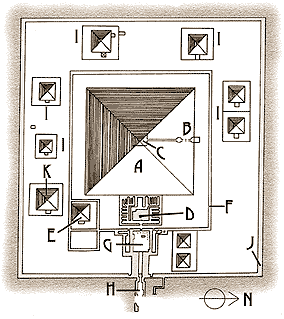 |
Orginally
came to power when he his father, Amenemhet I, took him as co-regent
in Year 20 of his reign. Sesostris I took major campaigns in
Syria, Nubia and Libya. it was while he was away from Egypt campaigning
in Libya that news reached him that his father had been assassinated
(these events are related in the 'Story of Sinuhe' and 'The Instruction
of King Amenemhet I for his Sesostris').
Sesostris
I then continued as sole king of Egypt, he increased the power
of the monarchy and increased Egypt's influence abroad using
diplomacy when dealing with Palestine and Syria - (although he
did send some military expeditions against the Libyans) . In
Year 18 Sesostris I started a campaign against the Nubians in
an effort to conquer and occupy lower Nubia - upto and including
the Third Cataract (and so were able to receive more gold, copper,
diorite, granite and amethyst).
|
 |
Domestic life in Egypt was helped by Sesostris'
firm government which gave stability to the country - Egypt was
prosperous.
Builldings
of Sesostris I
Sesostris
was a prolific builder - although very little remains survive
to present day. In Year 3 he rebuilt the temple to Re-Atum at
Heliopolis (where he also appears to have performed some of the
re-foundation ceremonies). In Year 30 he again built at Heliopolis,
this time he erected two 66ft red granite obelisks to celebrate
his sed-festival - unfortunately all that remains from the entire
temple site is a single obelisk.
Co-Regency
Sesostris
I continued the policy first started by his father of naming
his heir as co-regent: he took his son, Amenemhet II, as co-ruler
at least 3 years before his death.
Even
in the 12th Dynasty, Sesostris I had a divine cult - later legends
would refer to him as 'Pharaoh Sesostris' who would do amazing
deeds (however this 'Sesostris' was a combination of Sesostris
I, Sesostris III and Ramesses II).
|

|
When
he died, Sesostris I was buried in his pyramid at Lisht (a mile
south from his father's pyramid) - this pyramid is the best preserved
from the 12th Dynasty, and it revived the layout of the Old kingdom
pyramid complexes.
The
Pyramid of Sesostris I
Original
Height - 61m
Length
of Side 105m
|
 |
Also known
as the 'South Lisht Pyramid'. It was first discovered in 1882
by Gaston Maspero and excavated by J.E. Galtier and Gustave Jequier
in 1894. The pyramid was built by using great blocks of limestone
based on a central nucleus, spaces were filled with unfired bricks
- the whole structure was then covered with slabs of Tura limestone.
Inside
the enclosure wall of the pyramid were a further ten satellite
pyramids which were found to have belonged to members of the
royal family (these included Queen Nefru - slightly larger than
the others - , and the princesses: Itekuyet , Nefru-sobek, Nefru-Ptah,
Nenseddjedet) and dignitaries. Several Mastabas were also found
close to the pyramid - one of the most important being that of
Senusretankh (a High Priest of Ptah) whose funerary chamber was
decorated with Pyramid Texts.
 |
| A - Pyramid |
E - Satellite
Pyramid |
I - Secondary
pyramids (used for female members of the royal family) |
| B
- Entrance |
F - Inner
enclosure wall |
J - Outer
enclosure wall |
| C - Burial
Chamber |
G - Courtyard |
K - Pyramid
of Nefru (wife of Sesostris I) |
| D - Funerary
Temple |
H - Processional
Ramp |
|
|
|


